by Beth Bolles | Jun 17, 2013
There are a couple of possibilities for gardeners who are looking for something a little different than the old favorite French hydrangea. If you want to make your neighbor’s and gardening friends envious, consider adding one of the following selections to your garden.
The first to consider is the ‘Limelight’ hydrangea (Hydrangea paniculata) which is a hardy shrub and performs well in sunshine. New leaves emerge each spring and large greenish-white blooms emerge in the summer. Blooms may offer a color change into the fall, adding a delicate pink shade. This hydrangea should definitely be installed where it can be viewed and can grow 6-8 feet in height with a similar spread. Once established, it can be tolerant of some drought but will require moisture during extended dry periods.
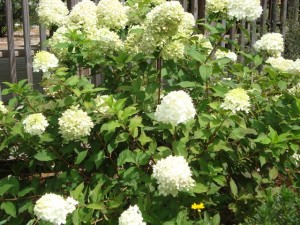
If you have a garden with more dappled shade, the ‘Fuji Waterfall’ hydrangea is a good selection. This hydrangea will require a soil with more consistent moisture and will offer interesting lacecap blooms that appear to cascade over the dark green leaves. Growth will have a layered look with plants reaching about 3 to five feet in height.
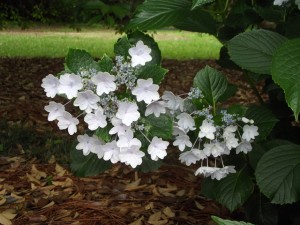
For more information on newer selections of hydrangeas for our climate visit the University of Florida publication New Hydrangeas for North and Central Florida: Bigleaf and Mountain Hydrangeas
by | Jun 4, 2013
Proper watering can make the difference between life and death to newly planted lawns, trees, shrubs, bedding plants, vegetable transplants and ground covers during the summer.
Because their roots have not had time to grow out into the surrounding soil, these plants do not yet have well-established root systems. With their root systems still limited to a relatively small area of soil, they are especially vulnerable to drought stress.
Trees
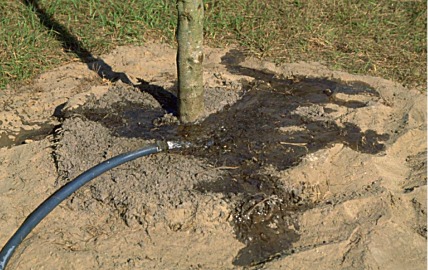 The first summer after planting is the most critical time for newly planted trees, and proper watering plays a major role in whether or not they survive – or how well they survive. Here are some effective watering techniques for trees.
The first summer after planting is the most critical time for newly planted trees, and proper watering plays a major role in whether or not they survive – or how well they survive. Here are some effective watering techniques for trees.
One good method is to turn a hose on trickle, lay the end on top of the ground within 6 inches of the trunk of the tree and let the water trickle for about 20 minutes to 30 minutes. Or build a 4-inch high levee out of soil around the edge of the area dug up to plant the tree. Fill this area with water and let it slowly seep into the root zone.
I’ve found one of the best methods is to use a heated metal skewer or ice pick to pierce five to 10 holes through the bottom of a 5-gallon paint bucket or similar container. Make all the holes on one side. Place the bucket next to the tree trunk with the holes closest to the trunk. Fill up the container, and the water will slowly seep through the holes, providing excellent irrigation. If you want, you can spray paint the outside of the bucket dark green to make it less noticeable.
Use any of these techniques during hot weather whenever seven to 10 days pass without substantial rainfall. Continue to water twice a week until a good rain occurs. Drought-stressed trees may experience wilting, leaf drop, yellow or brown leaves, scorched leaf edges or even death.
Shrubs
Newly planted shrubs will need to be monitored more carefully and watered more frequently than established shrubs. Water with soaker hoses or sprinklers left on long enough for the water to penetrate at least 4 to 6 inches into the soil.
Keep in mind that all of a newly planted shrub’s roots are in a small area – about the size of the pot the shrub was growing in before planting. This is especially true for shrubs planted after March, since they have had little time to grow roots into the surrounding soil. A shrub can use up all the water in its root ball and become drought stressed even though the soil in the bed outside of the root ball is moist. So when checking the soil moisture in the bed, always be sure to stick your fingers right around the shrubs themselves.
Lawns
 Now is a great time to lay sod to install a new lawn or repair an established one. But keep in mind that newly laid sod needs special attention to watering.
Now is a great time to lay sod to install a new lawn or repair an established one. But keep in mind that newly laid sod needs special attention to watering.
Water newly laid sod for about 15 to 20 minutes every day for the first seven to 10 days. Then water for about 30 minutes every other day for another seven to 10 days. After that, irrigate the lawn thoroughly once or twice a week, as needed, to encourage the roots to grow deep into the soil.
Do not water every day for more than 10 days or you may encourage fungus diseases. And, of course, there is no need to water if adequate rainfall occurs.
Seeds
Water seeded areas (vegetable seeds, flower seeds or lawn seeds) lightly by hand or with sprinklers every day until the seeds germinate and start to grow. It is critical for the soil to stay moist during germination.
Once the seeds come up, water more thoroughly less often to encourage the roots to grow deep into the soil. As the seedlings become established, water normally as needed.
Containers
 Watering plants in containers outside is a constant job during the summer. It is typical to water every day, even twice a day, when weather is hot and dry. Keep this in mind when considering how many outside container plants you can maintain.
Watering plants in containers outside is a constant job during the summer. It is typical to water every day, even twice a day, when weather is hot and dry. Keep this in mind when considering how many outside container plants you can maintain.
How often you have to water container plants is influenced by temperature, pot size, the type of potting mix, the drought tolerance of a plant, whether a plant is in sun or shade and how pot bound a plant is. Plants need to be watered more frequently when it is hot, if the containers are small, if a light potting mix is used, when plants are in a sunny location and when plants are pot-bound. In addition, clay pots tend to dry out faster than plastic or glazed ceramic pots.
To reduce the amount of watering you have to do, use larger rather than smaller pots, choose a potting mix that retains more water (it must still be fast draining, however), repot pot-bound plants into larger containers, use plastic pots and, if practical, move the plants into somewhat shadier conditions.
Potting mixes will retain more water with the addition of hydrophilic polymers. These gelatin-like particles hold large amounts of water without creating a waterlogged soil condition. Look for these polymer products or potting mixes that contain them where garden supplies are sold.
by Julie McConnell | May 2, 2013
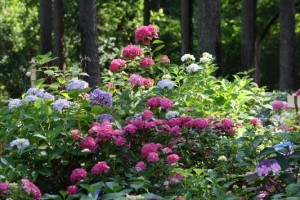
Hydrangeas
Bigleaf Hydrangea (Hydrangea macrophylla) are familiar faces in the southern shade garden. Although not originally from North America, they were introduced here over 200 years ago and perform well in the climate of the Florida Panhandle. Here are some quick tips about Bigleaf Hydranges.
- Hydrangeas prefer morning sun with afternoon shade or full shade and well-drained, moist soil
- The form is a mounding shrub that can have varying heights and widths, allow for a mature size on average of 6′ x 6′
- Hydrangeas have large green leaves that may be glossy or dull and are deciduous unless the winter is very mild
- There are two main flower types:mophead and lacecap
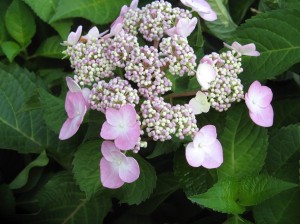
Lacecap Hydrangea
- Mophead flowers are rounded and usually composed of sterile flowers, with a few fertile flowers
- Lacecap flowers have sterile flowers on the outer edge of the circle, with fertile flowers in the center. When fertile flowers are fertilized they may turn a different color and the sterile flowers on the outer edge may invert themselves so they appear to be hanging down
- Flowers may be white, pink, purple, or blue; flower color is influenced by soil conditions and you may see multiple colors on the same plant!
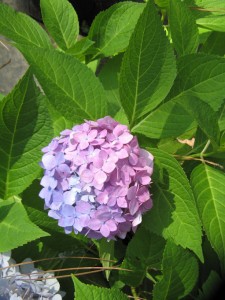
Penny Mac Hydrangea
- Bigleaf hydrangeas generally bloom on old wood, however, there are some types that will also bloom on new wood and fall into either “free-flowering” or “everblooming” categories. Free-flowering have flower buds on the tips of branches (old wood) and develop flower buds up and down the stem that flower after terminal (tip) buds flower. Everblooming hydrangeas form flower buds on the tips of both old wood and new wood and can flower throughout the season.
- If soils are sandy and infertile, add organic matter before planting
- Water as needed, especially during establishment phase (typically first year or two). Expect hydrangeas to wilt during hot summer afternoons, as with any plant check the soil moisture before irrigating to avoid overwatering
- Avoid overhead irrigation, leaf spot diseases and powdery mildew are more prevalent when foliage is wet for extended periods
- Prune after flowering, but before August when shaping is neededFor more information about long flowering hydrangea varieties see “New Hydrangeas for North and Central Florida: Bigleaf and Mountain Hydrangeas”
To learn more about influencing flower color and general care of hydrangeas read “French Hydrangea for Gardens in North and Central Florida.”
by Eddie Powell | Feb 15, 2013

As spring approaches, many gardeners get out the pruning shears and prune everything in sight. That might not be the best course of action! Take a look at these tips for flowering landscape shrubs to learn more about pruning techniques that will maximize amount of bloom.
Why Prune?
• Control plant size or form
• Remove damage (mechanical, disease, etc.)
• Prevent potential damage (overlapping branches, poor crotch angles, diseases, etc.
• Stimulate new growth (rejuvenate old plants, fill bare areas, increase flowering, etc.)
When to prune:
• Corrective pruning due to injury or dead tissue should be done as soon as evident.
• Avoid pruning from August 15 until plants are dormant.
• Most pruning should be done during the dormant season or immediately after flowering.
Rules of thumb:
• The “May Rule”.
• May defined if the plant blooms before May 1, prune immediately after flowering has ended (flowers produced on old wood or last year’s growth: Azaleas, Forsythia, etc.)
• If the plant blooms after May 1, prune during the dormant season (flowers produced on new growth: Crape Myrtles, Lilac Chaste tree, etc.).
• As with any rule there are exceptions: Oak leaf Hydrangea.
General rules of Pruning: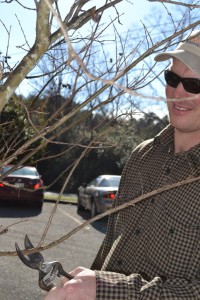
• Local in affect (usually within 6” of cut).
• Cuts should be made ¼” above a bud or to a crotch (Lateral branch).
• Cuts should be made at angles.
Pruning Equipment: (Make sure blades are sharp)
• Hand Snips (for small branches)
• Loppers (branches > 0.75” in diameter)
• Pruning Saw (limbs > 1.5” in diameter)
• Shears (for a more formal look)
• Pruning Knife (for clean-up)
Safe Pruning Principles:
• Keep equipment clean and in good repair.
• Appropriate, properly fitted safety equipment for job (eye and ear protection, no loose fitting clothes, etc.)
• Keep equipment within your control zone. Don’t over extend, know the limitations of your equipment and yourself.
• Know your surroundings (overhead utilities, other workers, etc.).
• Be able to identify Poison Ivy, Poison Oak, and other skin irritants.
Quick Tips to Remember:
• Pruning: Remove dead wood and seed pods annually during the dormant season.
• Size control should be done by cultivar selection, not by pruning.
• To promote a second set of flowers, prune away faded or spent flowers throughout the season.
For more information, click here for a UF / IFAS Extension publication on proper pruning techniques.
If you have any questions contact your local county extension agent.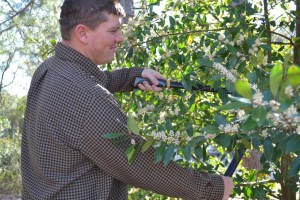
by Eddie Powell – Walton County Extension Horticulture Agent











